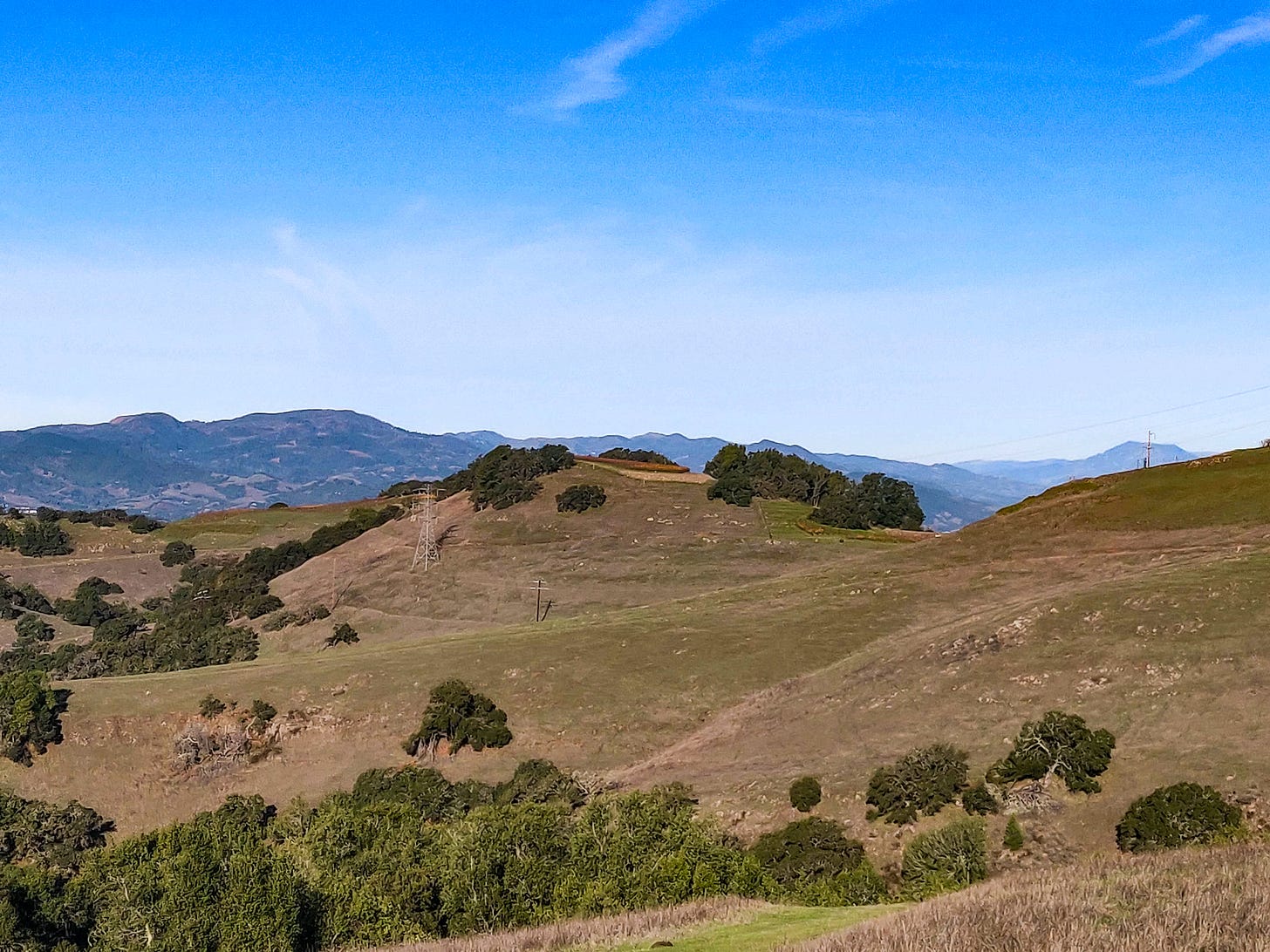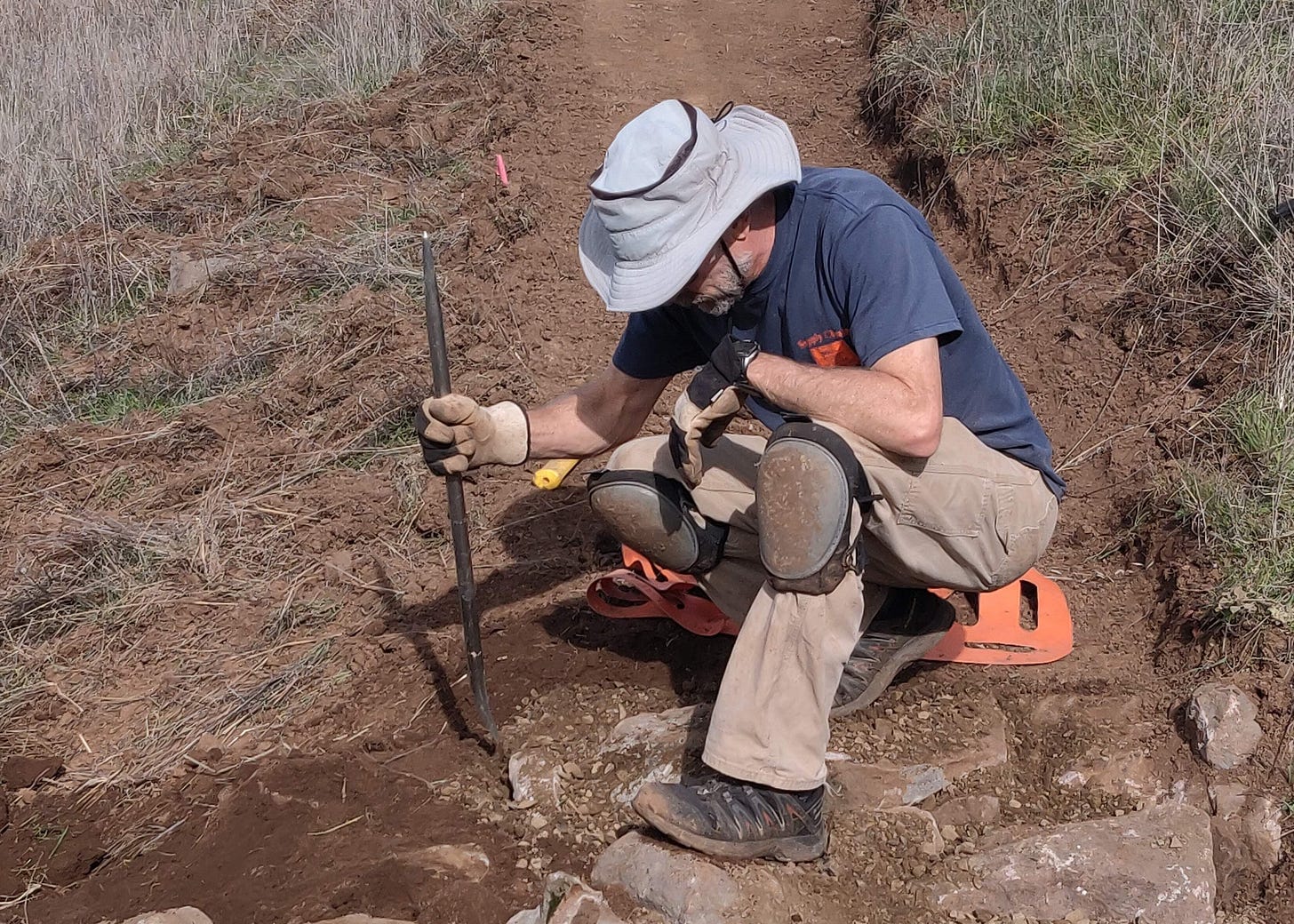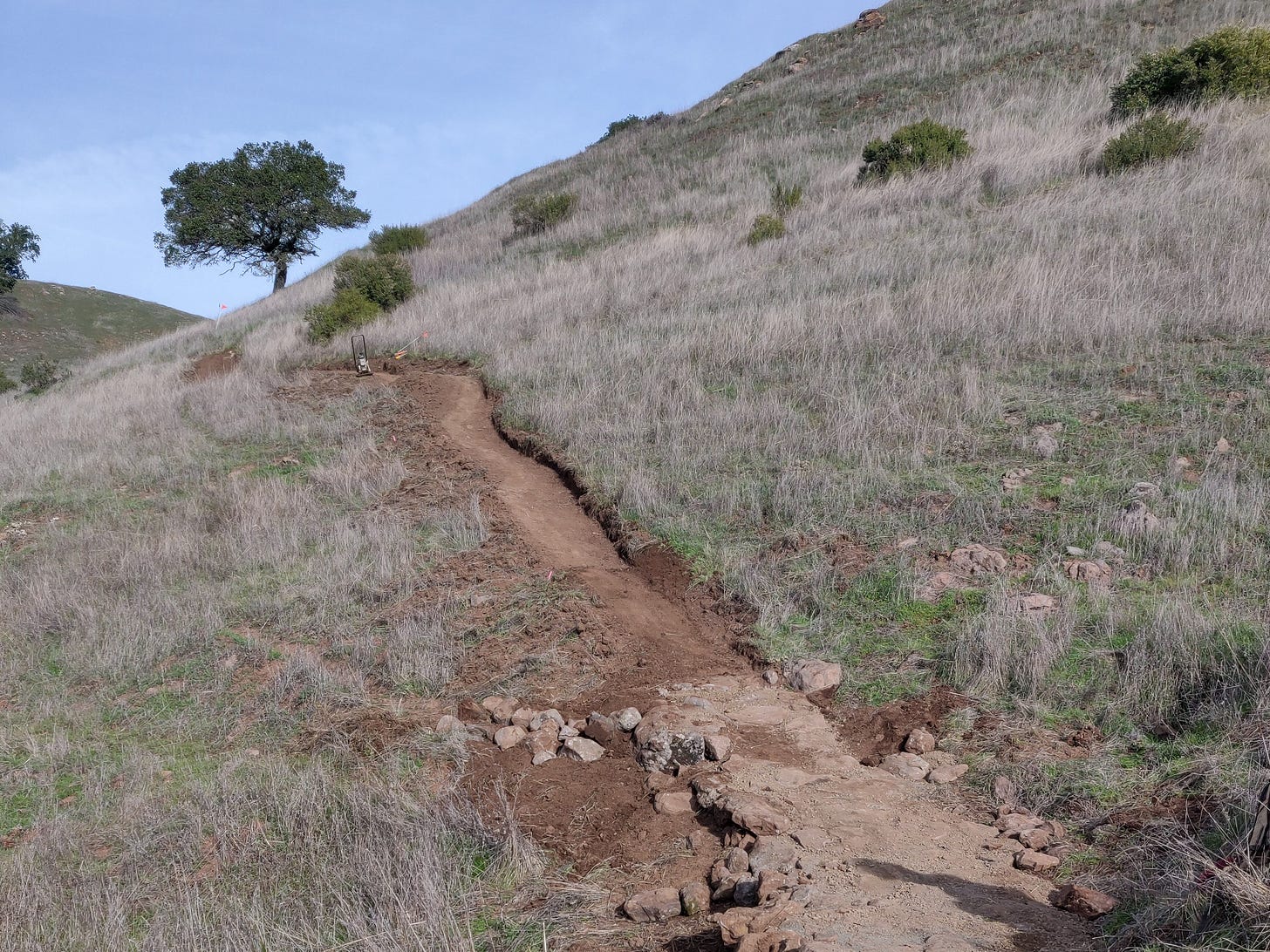NAPA VALLEY, Calif. — A small group of hardy volunteers stood in the early morning mist, high in the hills above the highway through Jameson Canyon. They had come to work on one of the newest projects of the Napa County Regional Park and Open Space District: the Suscol Headwaters trail system.
The Napa Open Space District acquired the 709 acres that comprise Suscol Headwaters Park between 2015 and 2017, but access has been limited to those who can hike more than 5 miles through Skyline Park just to reach it. That will soon change, thanks to work led by trail-design expert Kevin Smallman, who is charting the paths hikers and mountain-bikers will follow in the years to come.
On that recent winter morning, Smallman pointed to a row of tiny flags marking the route of the trail he had designed high above the highway through Jameson Canyon.
“We’ll need to run it through the grass there,” he said, “and then when we get to that swale, we’ll have to tackle the rockwork.”
The small group of volunteers carrying picks and shovels followed Smallman down the hillside and set to work, some carving out the tread, or path of the trail, while others went in search of large rocks that would stabilize the trail in the muddy swales. Meanwhile Smallman made suggestions, redirected a worker or picked up a tool to tackle a problem.
Smallman started his career twenty years ago.
“After a few years of working at a scout camp I pitched the idea of adding mountain biking to what was being offered,” Smallman said. “Little did I know this idea would consume much of my time for the next 20 years. That little trail system provided me with a sandbox to learn, try out ideas, often make mistakes and then consequently fix them.”
His experience and success led to an invitation to help build a trail at the popular Tamarancho trail system in Fairfax.
“I’m a trail addict,” he said. “I’ve learned that the more energy that goes into layout, the better the final trail. In the Napa Valley soil conditions vary widely, even on the same property. And the property changes through the year, and that's really special. We’ve been able to observe where the best wildflower blooms take place in the spring and have incorporated such a seasonal wonder into the design.”
When the volunteer crew took a well-deserved rest, Smallman explained where the trail would lead, where it would connect to other routes and how it would tie into the larger trail system of Skyline Park. The 14 miles of trails being built in this park make up just one of many projects the district is undertaking this year, despite being severely understaffed and perennially underfunded.
Since being created as a special district in 2006, Napa County Regional Park and Open Space District has never had dedicated tax-base funding, which is usually the funding mechanism for such districts. Instead, the group has relied on a grant from the Board of Supervisors from the Community Investment Fund, and they have had to be persistently creative with grant funding, community donations, in-kind donations, and hours of volunteer work to accomplish their goals.
The district manages the day-to-day operations of 10 locations and more than 13,000 acres in Napa County, including three state parks and more than 160 miles of trails, not counting the 14 miles at Suscol Headwaters. The parks are located in both urban and rural areas, and almost all of the trails are true multi-use pathways designed for all user groups from hikers and cyclists to equestrians and trail-runners. They do this with a full-time staff of 10 permanent employees, six of whom work in the three state parks, and up to 20 part-time/seasonal employees who also focus primarily on the state park operations.

Ryan Ayers, in charge of community relations and outreach for the district, is quick to stress the importance of the volunteers.
“We have an aggressive goal,” Ayes said. “We want to effectively turn every dollar of that funding into three or more. And to do that we know how important our volunteers are. We never worry about running out of things for them to do.”
Ayers can recite a list of diverse partnerships in land conservation and public recreation that get involved.
“Some of these partnerships are attached to the parks and trails under our umbrella,” he said, “like Pacific Union College. But we work with the Bay Ridge trails because a key section of that trail runs through Napa County and our Open Space District.” Last December more than 50 volunteers spent hours working on a section of that trail in Skyline Park, restoring areas that had been damaged by winter storms or overuse.
In early February a volunteer crew scheduled to work on the Moore Creek trail system was re-directed to help Napa-Bothe State Park recover from the windstorm that blew over massive trees and damaged the park’s water system, saving both time and money on the big project.
“Obviously I really like talking about our volunteers,” Ayers said. “They illustrate how hands-on this work is and how the community takes ownership of their parks and gets involved. We have regular volunteer days, but we also have quite a lot of company volunteer groups that come out, partnered projects with our local Resource Conservation District and others, Eagle Scout projects and more.”
For their part, the volunteers seem to enjoy the work and cite a long list of reasons: exercise in the open air, access to remarkable scenic locations around the valley, and giving back to the community and the parks they have enjoyed over the years.
“It feels good,” said one volunteer on a crew working on the Moore Creek project above Lake Hennessey. “I get to hang out with some really nice people, doing some good for a place I love and making it better for everyone else. That’s a win-win-win.”
For the work crew at Napa-Bothe, Ayers even cooked up a batch of his famous chili to reward the volunteers with a warm lunch.
“I know how much they contribute to our operations,” he said. “They really do allow us to multiply every dollar we get by three or four. Without them, it would be a very different story.”
Back up at Suscol Headwaters, the mist had burned off, and most of the day had been sunny and warm. From the work site, volunteers caught views of Mount Tamalpais, Mount Diablo, Mount St. Helena and most of the Napa Valley. Smallman told the crew that on a clear day you can even see the Sierra Nevada, far to the east. He wrapped up the day’s work by inspecting the last section of rock work and gave it his approval.
“In the winter, the spots where a seasonal stream crosses the trail can become a muddy mess,” he said. “This one looks like it will hold up pretty well.”
Anyone interested in joining a trail crew can connect with a number of local organizations that can help make that happen, and many of them work cooperatively to maximize the available volunteer labor. The links below lead to four such local organizations. In addition, Patagonia and the state of California have their own volunteer clearing houses for a variety of activities, from building trails to office work and everything in between.
Get involved:
For broader opportunities, consider these links:
If today's story captured your interest, explore these related articles:
Paul Wagner's career includes 29 years as an instructor at Napa Valley College's Viticulture and Winery Technology Department, authorship of award-winning wine marketing books and numerous speaking engagements at global conferences.









Thanks for a great story. I love hiking Napa County's trails and appreciate the efforts of all involved in creating, maintaining and making them available to the public.